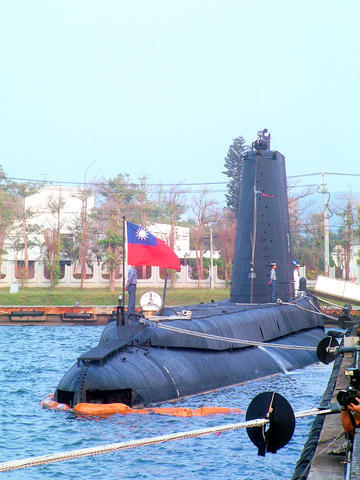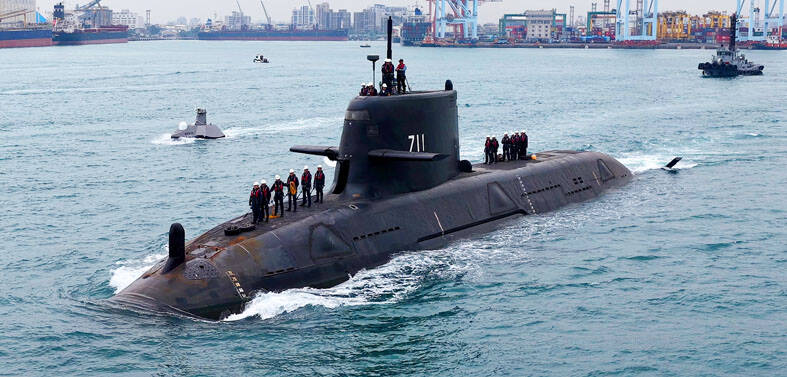The Navy celebrated the 63rd birthday of its oldest vessel -- the Guppy-class SS-791 Sea Lion submarine -- last Thursday.
The SS-791 was not only celebrating its 63rd birthday, but also its 34th year of service in the Navy. Along with the SS-792 Seal, the SS-791 is one of two existing "miracles" in the navy, as it is the oldest submarine still in service.
As part of the Mutual Defense Treaty between the US and the Republic of China (台美協防條約), in 1970 the US gave the SS-791 and SS-792 to the Taiwanese Navy -- after serving 28 years in the US Navy.

PHOTO: CNA
In 1973, Captain Kuan Chen-ching (
During the ceremony last Thursday, Rear Admiral Wang Hsi-ling (汪希苓), Taiwan's military attache to the US who oversaw the arrangement in the 1970s, officially accepted the two vessels on behalf of Taiwan.
With old piping, big knobs and rudders, old panels, limited space and the pervasive oil smell, the interior of the submarine is strikingly reminiscent of scenes from World War II movies. Sonars and torpedo systems complete the experience.
Among the 75 sailors on board, only the captain enjoys a private room -- and it is smaller than one ping. Everybody else, including the first officer, shares a public room for sleep. Regular meals are provided by a kitchen approximately two pings in size. It takes more than an hour for everybody on board to finish their meal as only 20 people can fit in the dining room at any given time.
With its 5,200 horsepower diesel engine, the SS-791 was initially capable of completing a non-stop 8,350km trip in approximately 45 days. Top speed under water was 12 knots and 16 knots on the surface.
A rumor that could have proven harmful to the navy's image and affect sailors' morale haunted the vessel since its acquisition, however. Some believed there was a real chance that after diving, the two Guppy-class subs would never resurface.
But SS-791 Warrant Officer Liu Tsai-hsin (劉財心) explained why the rumor never turned into reality.
"There is an air tank inside the vessel. When the submarine is on the surface, its entire weight is approximately 1,800 tonnes. When we need to dive, however, the air tank will take in 3,000 pounds [1,360kg] of air, turning the vessel into a 2,400-tonne rock. The system may be old, but it is reliable," Liu said.
Between 1944 and 1946, the US built 45 Tench-class submarines. Fourteen of those were upgraded to Guppy-class in 1950, including the SS-791.
Prior to joining the Taiwanese fleet, the SS-791 was known as the USS-478 Cutlass. It was built in the Portsmouth Naval Shipyard in Kittery, Main, and completed on Nov. 5, 1944.
The vessel was initially equipped with 10 torpedo launch tubes and sonar systems, with 11 officers and 70 petty officers and sailors.
But the US government's plan to help Taiwan's destroyer fleet conduct anti-submarine warfare resulted in the removal of all torpedo systems from the sub before it was handed over.
After it came into service, the Navy tried to restore its torpedo capability, but its indigenous system never reached optimal operability and the SS-791 was eventually allocated for training purposes.
The Navy's Fleet 256 chief of staff Rear Admiral Yang Yi (楊木益) believes the SS-791 can still make a contribution to the training of the Navy's next generation of officers.
"It is a tough environment for future naval officers to grow in. It is small, old and slow," Yang said. "But, the vessel itself is truly a legend."
Although it is the oldest submarine in service, many contemporary high-ranking naval officers have served on board the SS-791, including Minister of National Defense Lee Jye (李傑), Deputy General-Chief-of-Staff Admiral Wang Li-shen (王立申) and Deputy Commander-in-Chief of the Navy Lieutenant General Shen Po-chi (申伯之).
Lee was a lieutenant commander when the SS-791 was given to Taiwan and was also the first weapons chief on board the Sea Lion. He later became the third captain of the SS-791.
After new submarines are acquired by the Navy, the Ministry of National Defense will retire the SS-791 and the SS-792. Navy enthusiasts expect the two vessels will be restored after they retire and hope one will be used for training purposes at the Naval Academy while the other will be ported and turned into a museum.

US climber Alex Honnold is to attempt to scale Taipei 101 without a rope and harness in a live Netflix special on Jan. 24, the streaming platform announced on Wednesday. Accounting for the time difference, the two-hour broadcast of Honnold’s climb, called Skyscraper Live, is to air on Jan. 23 in the US, Netflix said in a statement. Honnold, 40, was the first person ever to free solo climb the 900m El Capitan rock formation in Yosemite National Park — a feat that was recorded and later made into the 2018 documentary film Free Solo. Netflix previewed Skyscraper Live in October, after videos

NUMBERS IMBALANCE: More than 4 million Taiwanese have visited China this year, while only about half a million Chinese have visited here Beijing has yet to respond to Taiwan’s requests for negotiation over matters related to the recovery of cross-strait tourism, the Tourism Administration said yesterday. Taiwan’s tourism authority issued the statement after Chinese-language daily the China Times reported yesterday that the government’s policy of banning group tours to China does not stop Taiwanese from visiting the country. As of October, more than 4.2 million had traveled to China this year, exceeding last year. Beijing estimated the number of Taiwanese tourists in China could reach 4.5 million this year. By contrast, only 500,000 Chinese tourists are expected in Taiwan, the report said. The report

Temperatures are forecast to drop steadily as a continental cold air mass moves across Taiwan, with some areas also likely to see heavy rainfall, the Central Weather Administration (CWA) said. From today through early tomorrow, a cold air mass would keep temperatures low across central and northern Taiwan, and the eastern half of Taiwan proper, with isolated brief showers forecast along Keelung’s north coast, Taipei and New Taipei City’s mountainous areas and eastern Taiwan, it said. Lows of 11°C to 15°C are forecast in central and northern Taiwan, Yilan County, and the outlying Kinmen and Lienchiang (Matsu) counties, and 14°C to 17°C

STEERING FAILURE: The first boat of its class is experiencing teething issues as it readies for acceptance by the navy, according to a recent story about rudder failure The Hai Kun (海鯤), the nation’s first locally built submarine, allegedly suffered a total failure of stern hydraulic systems during the second round of sea acceptance trials on June 26, and sailors were forced to manually operate the X-rudder to turn the submarine and return to port, news Web site Mirror Daily reported yesterday. The report said that tugboats following the Hai Kun assisted the submarine in avoiding collisions with other ships due to the X-rudder malfunctioning. At the time of the report, the submarine had completed its trials and was scheduled to begin diving and surfacing tests in shallow areas. The X-rudder,